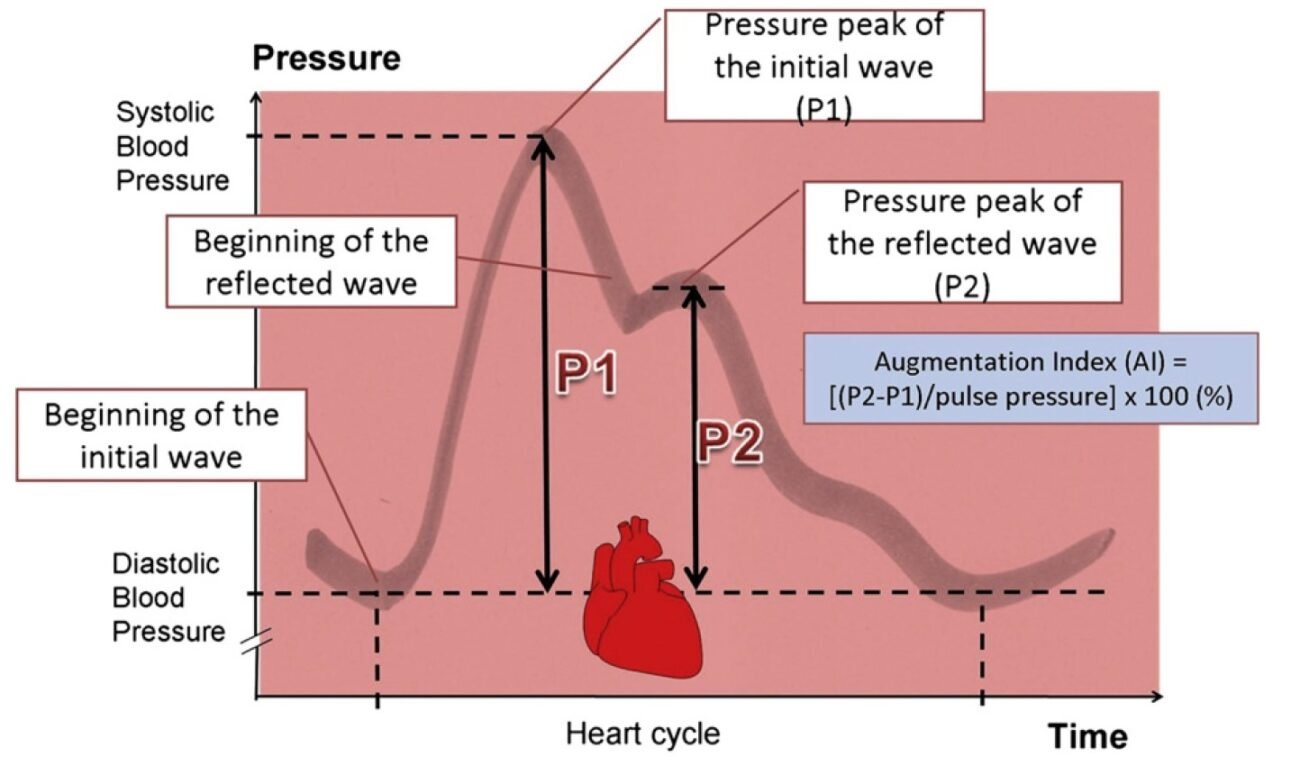Arterial stiffness is a normal part of aging that affects everyone. As we grow older, the walls of our blood vessels change and become less flexible [1]. While less than 1% of people have high aortic stiffness before age 50, this number increases to over 60% after age 70, especially among women [2]. Therefore, understanding arterial stiffness parameters is important for evaluating the health of the cardiovascular system.
Arterial stiffness parameters can be categorized into two groups:
- Directly Dependent Parameters:
-
- Pulse Wave Velocity (PWV)
- Indirectly Dependent Parameters:
-
- Central Systolic Blood Pressure (CSBP)
- Central Pulse Pressure
- Central Augmentation Index
This classification clearly shows the difference between parameters that are directly related to arterial stiffness and those that are affected by other factors [3]
What does Pulse Wave Velocity (PWV) mean?
Pulse wave velocity (PWV) is now becoming an essential tool in assessing cardiovascular health. It provides valuable insights into the condition of a person’s cardiovascular system. Basically, PWV measures the speed at which the pulse wave, generated by the heart, travels through the arteries. This speed correlates closely with the flexibility or stiffness of the arterial walls. In younger, healthier individuals, blood vessels are generally more flexible, causing the pulse wave to move more slowly. Conversely, stiffer arteries cause the pulse wave to travel faster, resulting in a higher PWV reading [4]. Since arterial stiffness is a critical indicator of cardiovascular health, PWV is instrumental in evaluating a person’s risk for cardiovascular disease and in tracking changes in vascular health over time.
The “2024 ESC Guidelines for Managing High Blood Pressure and Hypertension” recommend using a pulse wave velocity (PWV) threshold of over 10 m/s as a general indicator of increased risk [5]. There are various PWV types, such as carotid-femoral PWV and aortic PWV. Since we are primarily interested in assessing the elasticity and flexibility of the aorta, the most accurate measurements are typically aortic PWV or carotid-femoral PWV.
What is Central Systolic Blood Pressure (CSBP)?
Measuring blood pressure (BP) is essential for evaluating a patient’s health, typically conducted at the brachial artery in the arm. However, it is important to note that systolic blood pressure (SBP) can vary depending on the measurement site. This variation occurs due to pressure waves traveling through the arteries and reflecting at points where they bifurcate or change in diameter.
Central systolic blood pressure (CSBP) is measured at the aortic root, the primary section of the aorta that carries blood from the heart. This measurement is particularly significant as it represents the pressure experienced by vital organs such as the heart, brain, and kidneys [6].
On average, CSBP tends to be about 10 mmHg lower than brachial blood pressure. This discrepancy is common among healthy individuals and provides a more accurate representation of pressure in central arteries compared to arm readings alone. Research indicates that approximately 10% of individuals exhibit significant differences between central and brachial BP levels. In certain cases, CSBP may be elevated even when brachial BP readings appear normal. This finding shows the potential benefits of measuring CSBP, as it can offer healthcare providers valuable insights for more effective blood pressure management, identifying risks that traditional arm measurements may overlook.
Recent studies have shown that newer blood pressure medications, such as renin-angiotensin-aldosterone system inhibitors and calcium channel blockers, are more effective than older treatments in lowering central blood pressure. This advancement highlights the importance of considering CSBP in hypertension management [7].
What is Central Pulse Pressure?
Pulse pressure is defined as the difference between systolic and diastolic blood pressures. Similarly, aortic (central) pulse pressure (PPao) is the difference between central systolic and diastolic pressures. It shows the strength of each heartbeat. When pulse pressure is high, it can mean there’s a problem with the aortic valve, like a leak, or if the valve is healthy, it might point to stiffer arteries. Stiff arteries are a concern because they’re linked to higher risks of heart disease and heart attacks [8]. A central pulse pressure below 50 mmHg is generally considered normal and a sign of healthy arteries [9].
The formula for pulse pressure is:
Pulse Pressure = Systolic Blood Pressure – Diastolic Blood Pressure
In simple terms, pulse pressure depends a lot on stroke volume, which is the amount of blood the heart pumps with each beat. When stroke volume is high, pulse pressure goes up. But pulse pressure also depends on the flexibility of the arteries. If arteries are stiff, they resist blood flow more, which can increase pulse pressure.
There’s a basic formula that helps explain this relationship:
Pulse Pressure ≈ Stroke Volume / Arterial Compliance
This formula means that pulse pressure rises if the heart pumps more blood with each beat or if the arteries become stiffer. So, someone with high pulse pressure might have either a strong heart pumping a lot of blood, stiffer arteries, or both. This is important to know because a high pulse pressure can be a warning sign of health risks, like a higher chance of heart disease or stroke, especially if the arteries are getting stiffer over time [10].
What is Central Augmentation Index?
The Augmentation Index (AIx) measures how much extra pressure is added to blood flow in large arteries, like the aorta, with each heartbeat. This added pressure occurs because some blood flow bounces back from smaller arteries and combines with the main wave of blood pumped by the heart. AIx helps doctors understand how stiff a person’s arteries are indirectly; when arteries are stiffer, the reflected wave reaches the heart faster, adding pressure sooner and raising the AIx. A higher AIx can indicate that the heart is working harder, which over time can increase the risk of cardiovascular problems [11].
The central Augmentation Index indicates the flexibility or stiffness of the smaller blood vessels in the body. This flexibility is influenced by a natural substance called nitric oxide, produced by the inner lining of blood vessels. Nitric oxide helps these vessels relax, so its presence in the body can affect the stiffness of the small blood vessels. An AIxao (Central Augmentation Index) under 33% is considered normal, indicating healthy arterial function [12].
In each heartbeat cycle, the heart creates a pressure wave that travels through the aorta. When this wave reaches a branching point, part of it bounces back toward the heart. This results in two pressure peaks in each cycle: the first, called the “initial” or “direct” wave, and the second, called the “reflected” wave. The Augmentation Index (AIx) calculates the difference between these two peaks, using the formula:
AIX = (Pressure peak of the reflected wave (P2) – Pressure peak of the direct wave (P1)) / (Pulse Pressure) x 100. [13]
Arterial stiffness parameters measurement device
The measurement of arterial stiffness parameters is crucial, as it provides valuable insights into both direct and indirect indicators of arterial stiffness and asymptomatic diseases, such as atherosclerosis. Invented and patented by the elite gynaecologist Professor Milos Illyes, the Arteriograph is a revolutionary device that easily evaluates arterial stiffness parameters in less two minutes, all without human intervention and guaranteeing a completely painless experience for the patient.
Contact us to get answers to any questions you may have or to get a quote for the Arteriograph set.




